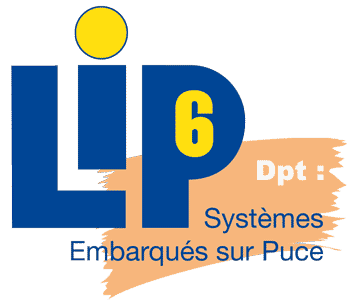ALMOS distribution for the TSAR many-core
Summary
Running ALMOS on the TSAR virtual prototype requires the installation of several open-source technologies like a GCC cross-compiler for Mips (el), SocLib virtual prototyping library, TSAR related components, and SystemCASS. To simplify the task of building and configuring a correct development environment, ALMOS comes with a stand-alone and ready-to-use distribution.
Mainly, this distribution enables you to:
- Port your own applications and libraries to ALMOS.
- Run these applications on TSAR using several configurations ranging from 4 to 1024 cores.
- Analyse the performance of your applications or the totality of the software-stack on a large-scale many-core.
Upon your needs you can also use this distribution to:
- Validate and evaluate any kernel new features or updates.
- Experiment and develop new parallel programming libraries and run-times for a large-scale single-chip many-core.
- Consolidate/build your own educational materials in the field of operating systems and parallel programming.
- Validate and evaluate any hardware evolution/development of a TSAR based architecture.
Compatibility
The distribution package contains some binary executables (e.g. GCC cross-compiler, TSAR simulator). These programs can run on a Linux based distribution. They were tested on Ubuntu 10.04/12.04 and on Scientific Linux 6.2. Both of 64 and 32 bits host machines are supported.
Setup
Download the latest stable distribution from this link. Decompress the .tbz2 file:
$ tar jxf almos-tsar-mipsel-1.0.tbz2
Now you have a sub-directory named almos-tsar-mipsel-1.0. In the remaining of this page, we refer to the absolute path to this directory as DISTRIB.
Start the simulation
Before any use of the distribution package you need to set some environment variables:
$ cd DISTRIB $ source ./SourceMe
Note: by default you have to source this file from its local directory: that is, you have to be in the DISTRIB directory before typing the source command.
Now, lets go to DISTRIB/test/pf1 and run make sim1:
$ cd DISTRIB/test/pf1 $ make sim1
This will launch the TSAR full-system simulator with its 4 tty terminals and one frame-buffer window. You will end by having a shell prompt on the tty1.
That is it ... you are done !!
The tty0 and tty3 are reserved for the kernel logs. For a user application, the tty1 represent the stdin and stdout while the tty2 represent the stderr.
Sim1 rule means the simulator of TSAR is configured to one cluster: that is, 4 cores. Using sim4, sim16, sim64 or sim128 lets you start the simulator with (respectively) 4, 16, 64 or 128 clusters of 4 cores each. The frame-buffer is only present when using the sim1 rule. For the other supported rules, the frame-buffer is absent (by default).
Note: although the hardware configuration can be changed at each simulation, there is no need to recompile or regenerate the kernel. The kernel of ALMOS detects the hardware resources at each boot. A user application can get the number of online cores using the standard sysconf() call (man sysconf).
Now lets take a look inside the DISTRIB/test/pf1 directory.
$ ls DISTRIB/test/pf1 arch-info.bin bootloader.bin hdd-img.bin kernel-soclib.bin Makefile
After each make simN command (where N is 1, 4, 16, 64 or 128) you will have at least 4 .bin files. These bins are required by the simulator. In the TSAR simulated platform, there is a ROM component and a H.D.D controller. The ROM will be filled with the contents of arch-info.bin, bootloader.bin and kernel-soclib.bin before starting the simulation. The hdd-img.bin is a FAT32 file system image sought by the H.D.D controller at each sector transfer.
The kernel-soclib.bin file is the ALMOS kernel while the bootloader.bin file is the ALMOS boot-loader for TSAR. The arch-info.bin file contains the description of the TSAR hardware resources. This file is regenerated (copied from DISTRIB/test/arch-bins) at each make simN command.
You can take a look to DISTRIB/test/pf1/Makefile. This file lets you customize some parameters like the used ALMOS kernel revision and the number of simulator threads. If you want to run simultaneously several configurations, lets say 4, you can create 3 additional DISTRIB/test/pf[2-4] directories each with its own customized Makefile. Than in each of these pfX directories you can type your make simN command.
Note: by default, the location from where the corresponding kernel revision is looked for is DISTRIB/test/kern-bins. The number of simulator's threads should not exceed the number of the physical CPUs (not the logical one) of your host machine. Finally, the hdd-imge.bin is a symbolic link to DISTRIB/test/misc/hdd-img.bin so be careful to provide an hdd-img.bin regular file per pfX directory when you run simultaneously a multiple instances of the simulator.
Your first application
Lets change the cap and look to how we can compile and run a user application for ALMOS/TSAR target. This task can be resumed in 4 steps:
- Write your application
- Cross-compile it using ALMOS headers and libraries
- Install it on the hdd-img.bin file system image
- Go to your DISTRIB/test/pfX directory and run the TSAR simulator
Some examples of applications source-code can be found in DISTRIB/apps. Lets try the hello_world one. The main() function of this application asks the system for the number of online cores (count) and then it fires count threads before it synchronizes on their termination. Each fired thread executes the thread_func() function which prints a "Hello World" message.
To cross-compile the application using ALMOS headers and static libraries:
$ cd DISTRIB/apps/hello_world $ make TARGET=tsar
The result is the ./hello program for ALMOS. To install this program into ALMOS's file system (hdd-img.bin). Just type:
$ make install
This will copy the hello program located in your current directory on your host machine (Linux) to /bin/hello inside the hdd-img.bin file system image.
Now, lets go to the DISTRIB/test/pf1 directory and launch the simulator:
$ cd ''DISTRIB/test/pf1'' $ make sim1
Wait until you get a prompt in the tty1 console, then type:
[/HOME/ROOT]>ls /bin
The contents of /bin directory will be listed and the hello program must figure in the list. To run /bin/hello program, type the following command in the tty1 console:
[/HOME/ROOT]>exec /bin/hello
You can see some kernel log messages on the tty0 and tty3 until you see the output of your hello program arrives on the tty1.
That is it ... you are done !!
Note: the kernel of ALMOS takes its own dynamic decisions about the management of the hardware resources including threads placement and cores load-balancing. Nevertheless, you can explicitly place the new process on a given core by using the argument -p core_number of the exec command (e.g. exec -p 3 /bin/hello). This concerns only the first thread which executes the main() function. If you want to control the placement of the next threads, you can use the pthread_attr_setcpuid_np() function to set the core number on which the new thread will be pinned (e.g. DISTRIB/apps/bcv/main.c).
In a normal situation your application may have some bugs and you need to validate it. The recommended and most convenient method is to test and validate your application on Linux before corss-compiling it for ALMOS. Lets go back to DISTRIB/apps/hello_world and clean the directory before compiling the same application for Linux:
$ cd ''DISTRIB/apps/hello_world'' $ make realclean $ make TARGET=linux
This will generate the ./hello program for Linux. To run it, just type:
$ ./hello
Now, lets take a look to the Makefile:
$ cat ./Makefile FILES=main BIN=hello ADD-CFLAGS=-O3 HDD=$(ALMOS_TEST)/pf1/hdd-img.bin include $(ALMOS_TOP)/include/appli.mk install: mcopy -i $(HDD) $(BIN) ::bin/.
The ALMOS_TEST and ALMOS_TOP are an environment variables exported by sourcing the DISTRIB/SourceMe file from the DISTRIB directory. The fist one is equivalent to DISTRIB/test directory while the second is equivalent to DISTRIB/almos.
The mcopy command enables you to copy a file from your host machine file system to a FAT file system image and in particular to the hdd-image.bin. mdir and mdel are another two useful utilities from the mtools package (see man mtools).
Running without the interactive mode
As you may certainly noticed, the simulation speed is slow. This because the simulator is cycle and bit accurate: that is, the simulation includes the evolution of all hardware FSMs (Finite State Machine), data movements and contentions on all hardware resources at a cycle and bit precision.
For a large TSAR configuration starting from sim16 (i.e. 16 x 4 = 64 cores) or even if you just want to launch several instances of the simulator with different configurations, you need to disable the interactive mode in favor of a batch execution mode. This can be done by following 2 steps before running a simulation:
- Redirecting the simulator ttys output to files
- Write a mini-script to let the shell automatically executes your programs
To do the first step you have to set an environment variable SOCLIB_TTY as fallows:
$ export SOCLIB_TTY=FILES
Now, lets go to DISTRIB/test/pf1 directory and edit a new shrc script with the following contents:
echo started echo exec /bin/hello exec /bin/hello echo ended
This can be done as follows:
$ cd DISTRIB/test/pf1 $ cat > ./shrc echo started echo going to exec /bin/hello exec /bin/hello echo ended ^D
Lets show the ./shrc contents before coping it to /etc/shrc on ALMOS file system image hdd-img.bin:
$ cat ./shrc echo started echo going to exec /bin/hello exec /bin/hello echo ended $ mcopy -i hdd-img.bin ./shrc ::/etc/.
Note: the shrc file name and the /etc destination directory are required by the shell of ALMOS. The first user process executed by the kernel of ALMOS is /bin/init which forks and execs the shell /bin/sh. The sh will systematically look for /etc/shrc configuration file and executes all of its commands.
Now, we are ready to run the TSAR simulator for a while before killing it and inspecting the generated files:
$ make sim1 ^C
That is it ... you are done !!
Lets list the contents of pf1 directory:
$ ls arch-info.bin bootloader.bin hdd-img.bin kernel-soclib.bin Makefile shrc tty0 tty1 tty2 tty3
As you can see, there is tty[0-3] new files. They are the result of the redirection of simulator's ttys output into these files.
$ cat tty1 init: System Revision Info [Almos almix-v1.2 2011 tsar mipsel mips32] init: Listening to signals 15, 1 init: Connexion-Shell has been created [pid 2] started going to exec /bin/hello ended [/HOME/ROOT]>pid 3, tid 0, arg 0: Hello World !! pid 3, tid 2, arg 1: Hello World !! pid 3, tid 3, arg 2: Hello World !! Main: thread #0 has finished with return value 0 Main: thread #1 has finished with return value 1 pid 3, tid 4, arg 3: Hello World !! Main: thread #2 has finished with return value 2 Main: thread #3 has finished with return value 3
Any help?
You are welcome to subscribe to almos-users mailing list. This mailing list is dedicated to ALMOS users and it is the most appropriate place to ask about things relative to this distribution.

